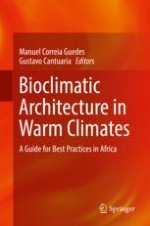2019 | OriginalPaper | Chapter
3. Bioclimatic Project: General Guidelines
Authors : Manuel Correia Guedes, Leão Lopes, Bruno Marques
Published in: Bioclimatic Architecture in Warm Climates
Publisher: Springer International Publishing
Activate our intelligent search to find suitable subject content or patents.
Select sections of text to find matching patents with Artificial Intelligence. powered by
Select sections of text to find additional relevant content using AI-assisted search. powered by
